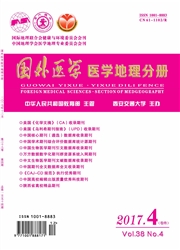

 中文摘要:
中文摘要:
目的 探讨大骨节病地区儿童与非大骨节病地区儿童内外环境中氟元素水平及其与大骨节病的关系.方法 采用氟离子选择电极法测定大骨节病地区与非大骨节地区水、土和粮食中以及大骨节病地区患儿与内、外对照组儿童的尿、发中的氟元素含量.结果 ①大骨节病地区水中氟含量为(0.24±0.10)mg/L、土中氟含量为(472.94±83 40)mg/kg和小麦中氟含量为(2.04±0.35)mg/kg显著低于非大骨节病地区水中氟含量为(0.26±0.08)mg/L、土中氟含量为(526.60±70.25)mg/kg、小麦中氟含量为(2.33±0.411)mg/kg;②大骨节病组儿童尿氟含量(0.87±0.34)mg/L、发氟含量(7.24±1.36)mg/kg及内对照组尿氟含量(0.92±0.42)mg/L;发氟含量(8.12±1.46)mg/kg显著高于外对照组尿氟含量(0.67±0.27)mg/L;发氟含量(7.24±1.36)mg/kg.结论 青海大骨节病儿童外环境氟元素含量偏低,而体内环境偏高,呈现体内、外环境氟元素含量不一致现象.
 英文摘要:
英文摘要:
Objective To investigate the differences of fluorine concentration between the internal and external environment of children with Kashin-Beck disease (KBD) in KBD and non-KBD areas to understand the relationship between fluorine and KBD. Methods Samples of drinking water, food, soil, hair and urine collected from children both KBD, the healthy and their family's in the KBD and non-KBD areas of Guide and Tongde in Qinhai, and determinated the fluorine concentration using fluoride ion selective electrode. Results (1) Fluorine contents in drinking water: (0.24±0.10) rag/L, soil: (472.94 ± 83.40) mg/kg and wheat: (2.04±0.35) mg/kg in KBD area was lower than that in non-KBD area water : (0.26 ±0.08) mg/L, soil: (526.60 ± 70.25) mg/kg, wheat : (2.33±0. 411) mg/kg (2) Fluorine contents of urine: (0.87±0.34) mg/L and hair, (8.12±1.46) mg/kg of KBD children group and the healthy control urine: (0.92±0.42) mg/Land hair: (8.12±1.46) that of non-KBD area urine (0. 67±0.27) mg/L and hair: (7.24±1.36) mg/kg. Conclusion mg/kg were higher than Fluorine contents of the external environment were significantlylower, but higher in the internal environment of KBD children in Qinghai. It indicated that fluorine contents between the internal and the external environment of human body were inconsistencies.
 同期刊论文项目
同期刊论文项目
 同项目期刊论文
同项目期刊论文
 期刊信息
期刊信息
